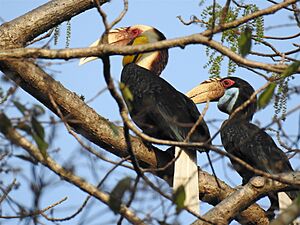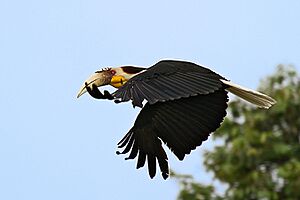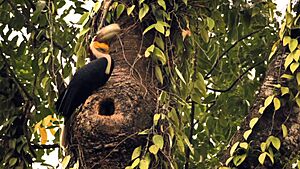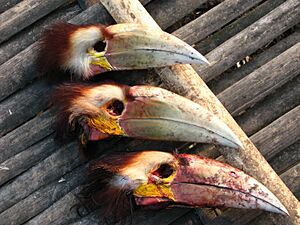Wreathed hornbill facts for kids
Quick facts for kids Wreathed hornbill |
|
|---|---|
 |
|
| Male in Pakke Tiger Reserve | |
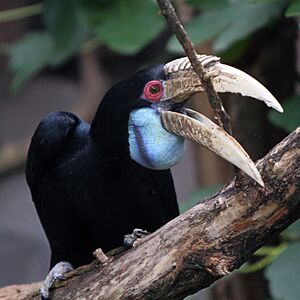 |
|
| Female at Ouwehands Dierenpark | |
| Conservation status | |
| Scientific classification | |
| Genus: |
Rhyticeros
|
| Species: |
undulatus
|
| Synonyms | |
|
Aceros undulatus |
|
The wreathed hornbill (Rhyticeros undulatus) is a large, colorful bird found in tropical forests. It belongs to the hornbill family. People sometimes call it the bar-pouched wreathed hornbill. This is because of a special blue-black band on its throat. Its name comes from the ridges, or "wreaths," that grow on its bill as it gets older.
Male wreathed hornbills are black with a reddish-brown head. They have a white face and chest, and a yellow throat. Females are all black with a blue throat. They are a bit smaller than the males.
These hornbills live in the forests of Northeast India, Bhutan, Bangladesh, Southeast Asia, and the Greater Sunda Islands. They mostly eat large fruits, which they swallow whole. This helps spread seeds far and wide in the forest.
Sadly, the wreathed hornbill is in danger. Hunting, cutting down forests, and breaking up their homes are big problems. Since 2018, it has been listed as a Vulnerable animal. This means its numbers are expected to drop.
Contents
About the Wreathed Hornbill
The wreathed hornbill is a black bird with black legs and feet. It has a pale yellow bill. The skin around its eyes is reddish, and it has a black band on its throat. Its tail is white.
Male birds have a bright yellow throat. Their neck is white, and the back of their neck is dark reddish. Female birds have a blue throat. Young hornbills look more similar. But as they grow, the differences between males and females become clear.
This is a medium-sized bird. It can be about 75 to 90 centimeters long. Adult males weigh between 1.68 and 3.65 kilograms. Females weigh from 1.36 to 2.69 kilograms.
Their Special Bill
All hornbills have big, heavy bills. They also have a special growth on top called a casque. This casque helps tell them apart from other birds. The casque is light inside, like foam, but has a hard outer shell. The first two bones in their neck are joined together. This helps support the heavy bill.
The wreathed hornbill's bill has unique ridges near its base. As the bird gets older, the front ridge can break off. Scientists think these special bills help hornbills in many ways. They might make their calls louder. They could also be used for fighting, showing off to find a mate, or to show how old or important a bird is.
Where They Live
Wreathed hornbills live in tropical evergreen forests. You can find them from southern Bhutan and Northeast India to Bangladesh. They also live across mainland Southeast Asia and in Indonesia. In Indonesia, they are found on islands like Sumatra, Java, and Borneo. They can live in forests up to 2,560 meters high.
In Northeast India, they live in untouched forests and some forests where trees have been carefully cut. They are found in places like Nameri National Park and Namdapha National Park. During the time they raise their young, they stay in lower areas. But when they are not breeding, they move to higher places.
How They Live
Wreathed hornbills are social birds. They are most active in the mornings when they look for fruit. During the middle of the day, they rest. Then they become active again in the afternoon.
They live in larger flocks than other hornbill species. They stay in groups all year round. These birds travel long distances to find fruit. They can even fly between islands. However, they do not migrate to different regions for seasons. One male hornbill was tracked with a GPS device. It flew about 24.8 kilometers each day. It helped spread seeds up to 10.8 kilometers from its nest.
Their Calls
The wreathed hornbill's main call is a loud double sound. It sounds like “coo-cuk” or “wuff-wurff.” This call is short and repeated many times. They make this sound when sitting or flying. The second part of the call is higher and louder. It can be heard from far away. When they call, they throw their head back. This shows off their bright throat sac. This movement might be a way for them to talk to each other. They also make other low, two-part barking sounds.
What They Eat
Wreathed hornbills mainly eat large fruits. Figs are a big part of their diet. They also eat more fleshy fruits than other hornbills. Sometimes, they eat small animals like insects, crabs, snails, and reptiles. They eat more of these small animals when they are raising their young.
They look for food in the tops of the forest trees. Sometimes, they go down to the ground to eat small prey or pick up fallen fruit. The amount of fruit available changes with the season and place. So, wreathed hornbills fly far to find areas with lots of fruit. As they move, they spread the seeds they eat. This seed dispersal is very important for keeping tropical forests healthy.
Wreathed hornbills use a special way to eat called "ballistic food transport." They hold a large fruit at the tip of their bill. Then they quickly throw their head back to swallow it whole. This helps them eat fruits that are too big for smaller fruit-eating birds. It also protects the seeds. The whole seed goes through their body and comes out unharmed. This increases the chance of the seed growing into a new plant.
Reproduction and Life Cycle
Wreathed hornbills are monogamous, meaning they have one mate. Both parents help care for their young. They build nests in hollows inside large trees. These trees can be in coastal forests or in hills up to 2,560 meters high. They look for existing holes because they cannot dig their own. Their nests are usually 18 to 28 meters above the ground.
The female uses mud or her own droppings to seal the nest hole. This protects her eggs and chicks from predators. She leaves a small gap for the male to bring food. She will unseal the hole if she needs to leave the nest.
A female wreathed hornbill usually lays 1 to 3 eggs. She sits on the eggs and guards them alone for 40 days. She only raises one chick. She stays with the chick in the nest until it is ready to fly, which takes 111 to 137 days. Both parents stay with the young bird for several months after it leaves the nest.
Why They Are in Danger
The biggest dangers to wreathed hornbills are hunting, the use of pesticides, illegal logging, and their homes being broken up. In Arunachal Pradesh, some local people hunt 50 to 70 wreathed hornbills during their travel season. They use the birds for food, medicine, and to decorate their homes and hats. Some people also hunt them for fun or use their fat for medical reasons.
Because of these threats, the wreathed hornbill has been listed as a vulnerable species since 2018. This means their numbers are expected to go down in the future.
Helping the Wreathed Hornbill
The wreathed hornbill is protected by international laws like CITES Appendix II. It is also a protected species in China.
In Pakke Tiger Reserve, a special program was started in 2011. It's called the Hornbill Nest Adoption Program. Local people from nine villages work as "nest protectors." They find and watch over hornbill nests. People from cities can help by giving money to support the project. In 2012 and 2013, these protectors found eight wreathed hornbill nests. Two of these nests successfully raised young birds.



